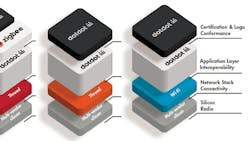ZigBee DotDot Dashes to Unify Connectivity Stacks
The new DotDot protocol stack was designed for the Internet of Things (IoT) in all its incarnations. The ZigBee Alliance is behind DotDot and is working with The Thread Group for one of the DotDot iterations. DotDot unifies the upper-level protocols being used in a number of IoT devices (see figure). In a sense, the ZigBee Alliance is renaming the upper levels of its protocols stack to be DotDot so it can be used with different network stacks and network hardware.
ZigBee’s multiple profiles have also been unified into a single DotDot application layer. It is designed to work with certified network stacks. At this point, the ZigBee Pro stack and the Thread Group’s Thread stack are work with DotDot. Additional stacks will be certified in the future. The public specification and certification process will be rolled out later this year. The first certified devices will likely appear on or before 2018.
DotDot extends ZigBee’s reach and provides Thread with a rich application layer. Thread can also be used with other application layers, but if it used to communicate with other DotDot devices, then they will use the DotDot application layer.
The approach provides IoT and embedded developers with more options in addition to making connections between different underlying networks easier, since a router simply has two protocol stacks. Networks protocols like IPv6, which is used by Thread and ZigBee, only comprise the lower part of the network stack.
Wireless network stacks are currently the target for DotDot, but it should work equally well with wired networks like Ethernet. This potentially allows for a single application protocol to span wired and wireless networks.
DotDot is not the only framework looking to be the universal IoT communication stack. For example, Google’s Nest Weave is built on Thread. Of course, DotDot has a significant following, including existing ZigBee supporters.
About the Author
William G. Wong
Senior Content Director - Electronic Design and Microwaves & RF
I am Editor of Electronic Design focusing on embedded, software, and systems. As Senior Content Director, I also manage Microwaves & RF and I work with a great team of editors to provide engineers, programmers, developers and technical managers with interesting and useful articles and videos on a regular basis. Check out our free newsletters to see the latest content.
You can send press releases for new products for possible coverage on the website. I am also interested in receiving contributed articles for publishing on our website. Use our template and send to me along with a signed release form.
Check out my blog, AltEmbedded on Electronic Design, as well as his latest articles on this site that are listed below.
You can visit my social media via these links:
- AltEmbedded on Electronic Design
- Bill Wong on Facebook
- @AltEmbedded on Twitter
- Bill Wong on LinkedIn
I earned a Bachelor of Electrical Engineering at the Georgia Institute of Technology and a Masters in Computer Science from Rutgers University. I still do a bit of programming using everything from C and C++ to Rust and Ada/SPARK. I do a bit of PHP programming for Drupal websites. I have posted a few Drupal modules.
I still get a hand on software and electronic hardware. Some of this can be found on our Kit Close-Up video series. You can also see me on many of our TechXchange Talk videos. I am interested in a range of projects from robotics to artificial intelligence.



